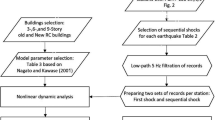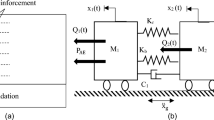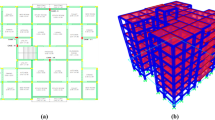Abstract
Seismic performance of a representative single-story confined unreinforced masonry school building in Tehran, Iran is evaluated by means of incremental dynamic analyses according to FEMA P-58 framework. For this purpose, fragility curves are derived for each of the constituent walls of the building. The in-plane behavior of the walls is considered only. Both flexible and rigid diaphragm conditions are investigated. For comparison purposes, the corresponding unconfined building exactly duplicating the considered confined unreinforced masonry building is also studied. In order to analyze the effects of near-source seismic actions on the performance of masonry buildings, two separate far-field and near-field ground motion sets containing 326 records are used. By utilizing the results of the incremental dynamic analyses and the available data of unreinforced masonry school buildings in Tehran, a scenario-based risk assessment of this type of school buildings is performed considering all three adjacent faults for three different earthquake magnitudes. Considerable performance improvement is achieved by providing confinement to the walls which leads to over $100 million reduction in the damage costs for masonry school buildings in Tehran. Also, significant reduction in seismic vulnerability, especially for unconfined masonry buildings, is observed by providing the roof with more rigidity. The findings in this study can be of direct use for disaster management of masonry school buildings in Tehran and similar cities.
























Similar content being viewed by others
References
Amiri GG, Dana FM (2005) Introduction of the most suitable parameter for selection of critical earthquake. Comput Struct 83(8):613–626
ASCE (2005) Minimum design loads for buildings and other structures (ASCE/SEI 7–05). American Society of Civil Engineers, Reston, VA, USA
ASCE (2013) Seismic rehabilitation of existing buildings (ASCE/SEI 41–13). American Society of Civil Engineers, Reston, VA, USA
Azizi-Bondarabadi H, Mendes N, Lourenço PB, Sadeghi NH (2016) Empirical seismic vulnerability analysis for masonry buildings based on school buildings survey in Iran. Bull Earthq Eng 14(11):3195–3229
Baker JW (2015) Efficient analytical fragility function fitting using dynamic structural analysis. Earthq Spectra 31(1):579–599
Bakhshi A, Ahmadi MH, Yekrangnia M (2014) Development of fragility curves of confined masonry buildings. 9th International masonry conference, Guimaraes, Portugal
Basim MC, Estekanchi HE (2015) Application of endurance time method in performance-based optimum design of structures. Struct Saf 56:52–67
Benjamin JR, Cornell CA (1970) Probability, statistics, and decision for civil engineers. McGraw-Hill, New York, USA
Berberian M, Yeats RS (2001) Contribution of archaeological data to studies of earthquake history in the Iranian plateau. J Struct Geol 23:563–584
Bommer JJ, Magenes G, Hancock J, Penazzo P (2004) The influence of strong-motion duration on the seismic response of masonry structures. Bull Earthq Eng 2(1):1–26
Campbell KW, Bozorgnia Y (2003) Updated near-source ground-motion (attenuation) relations for the horizontal and vertical components of peak ground acceleration and acceleration response spectra. Bull Seismol Soc Am 93(1):314–331
Chiou B, Darragh R, Gregor N, Silva W (2008) NGA project strong-motion database. Earthq Spectra 24(1):23–44
Dhakal RP, Singh S, Mander JB (2007) Effectiveness of earthquake selection and scaling method in new zealand. Bull N Z Soc Earthq Eng 40(3):160–171
Dolatshahi KM, Yekrangnia M (2015) Out-of-plane strength reduction of unreinforced masonry walls because of in-plane damages. Earthq Eng Struct Dynam 44(13):2157–2176
Dolatshahi KM, Aref AJ, Yekrangnia M (2014) Bidirectional behavior of unreinforced masonry walls. Earthq Eng Struct Dynam 43(15):2377–2397
Ebrahimian H, Jalayer F, Lucchini A, Mollaioli F, Manfredi G (2015) Preliminary ranking of alternative scalar and vector intensity measures of ground shaking. Bull Earthq Eng 13(10):2805–2840
EN 1052-3 (2002) Methods of test for masonry—Part 3: Determination of initial shear strength. European Committee for Standardization, Brussels
Fenves GL, Mazzoni S, McKenna F, Scott MH (2004) Open system for earthquake engineering simulation OpenSees. University of California, Berkeley, CA, USA, Pacific Earthquake Engineering Research Center
FEMA-395 (2002) Incremental seismic rehabilitation of school buildings (K-12). Federal Emergency Management Agency, Washington, D.C, USA
FEMA 461 (2007) Interim testing protocols for determining the seismic perfromace characterstics of structural and nonstructural components. Federal Emergency Management Agency, Washington, D.C., USA
FEMA 440 (2005) Improvement of nonlinear static seismic analysis procedures. Federal Emergency Management Agency, Washington, D.C., USA
FEMA P-440A (2009) Effects of strength and stiffness degradation on seismic response. Federal Emergency Management Agency, Washington, D.C., USA
FEMA-P-58 (2012) Seismic performance assessment of buildings. Federal Emergency Management Agency. Washington, D.C., USA
FEMA-P-695 (2009). Quantification of building seismic performance factors. Federal Emergency Management Agency, Washington, D.C., USA
Ghahari SF, Jahankhah H, Ghannad MA (2010) Study on elastic response of structures to near-fault ground motions through record decomposition. Soil Dyn Earthq Eng 30(7):536–546
Iranian code of practice for seismic resistant design of buildings (Standard 2800) (2015) Fourth Revision, Building and Housing Research Center, Iran (in Persian)
Jalayer F, Beck JL, Zareian F (2012) Analyzing the sufficiency of alternative scalar and vector intensity measures of ground shaking based on information theory. J Eng Mech 138(3):307–316
KhalafRezaei M (2012) Analytical and experimental evaluation of confined masonry walls retrofitted by shotcreting with ordinary and steel fibers concrete. MSc Thesis, Tarbiat Modares University, Tehran, Iran (in persian)
Kostov M, Koleva N (2007) Damage potential of the seismic strong motion. 8th pacific conference on earthquake engineering, Singapore
Lovon H, Tarque N, Silva V, Yepes-Estrada C (2018) Development of fragility curves for confined masonry buildings in Lima Peru. Earthq Spectra 34(3):1339–1361
Luco N, Cornell CA (2007) Structure-specific scalar intensity measures for near-source and ordinary earthquake ground motions. Earthq Spectra 23(2):357–392
Meli R, Brzev S, Astroza M, Boen T, Crisafulli F, Dai J, Farsi M, Hart T, Mebarki A, Moghadam AS, Quiun D, Tomazevic M, Yamin L (2011) Seismic design guide for low-rise confined masonry buildings. Confined Masonry Network, A Project of the World Housing Encyclopedia, EERI and IAEE, Oakland, CA, USA
Mitropoulou CC, Lagaros ND, Papadrakakis M (2010) Building design based on energy dissipation: a critical assessment. Bull Earthq Eng 8:1375–1396
Moehle J, Deierlein GG (2004) A framework methodology for performance-based earthquake engineering. 13th world conference on earthquake engineering and seismology (13WCEE), Vancouver, British Columbia, Canada
Moghaddam H (2015) Seismic design of brick buildings, 6th edn. Sharif University of Technology, Tehran, Iran
Mosalam KM, White RN, Gergely P (1997) Static response of infilled frames using quasi-static experimentation. J Struct Eng 123(11):1462–4169
Nazari H (2006) Analyse de la tectonique récente et active dansl’alborz central et la région de Téhéran: approche morphotec-toniqueet paléoseismologique, PhD thesis, University of Mont-pellier II
New Zealand standard structural design actions part 5: Earthquake actions (2004) (NZS1170.5), Wellington, New Zealand
Panahi M, Rezaie F, Meshkani SA (2014) Seismic vulnerability assessment of school buildings in Tehran city based on AHP and GIS. Nat Hazards Earth Syst Sci 14:969–979
Quiroz LG, Maruyama Y (2017) Seismic assessment of Peruvian confined masonry dwellings using fragility functions, 16th world conference on earthquake engineering and seismology (16WCEE), Santiago, Chile
Reinoso E, Ordaz M, Guerrero R (2000) Influence of strong motion duration in seismic design of structures. 12th world conference on earthquake engineering and seismology (12WCEE), Auckland, New Zealand
Rural houses specifications count (2003) Housing Foundation of Iran, Tehran, Iran
Sarrafi B, Eshghi S (2012) Experimental study on lateral strength of confined masonry walls. 15th world conference on earthquake engineering (15WCEE), Lisbon, Portugal
Shome N, Cornell AC, Bazzurro P, Carballo JE (1998) Earthquakes, records and nonlinear responses. Earthq Spectra 14(3):469–500
Tasnimi A (2004) The behavior of masonry walls constructed according to the Standard 2800. Building and Housing Research Center, Bulletin of research No 404, Tehran, Iran
Tomaževič M, Gams M (2012) Shaking table study and modelling of seismic behaviour of confined AAC masonry buildings. Bull Earthq Eng 10(3):863–893
Wen Y, Kang Y (2001) Minimum building life-cycle cost design criteria. II: applications. J Struct Eng 127:338–346
Yekrangnia, M, Mahdizadeh A (2009). URM Buildings and earthquake: in-depth evaluation of earthquake damages to URM buildings. Scientific report. Organization for Development, Renovation and Equipping Schools of I.R. Iran
Yekrangnia M, Bakhshi A, Ghannad MA (2017) Force-displacement model for confined masonry walls with shear-dominated failure mode. Earthq Eng Struct Dynam 46(13):2209–2234
Yekrangnia M, Mohammadi M (2017) A new strut model for solid masonry infills in steel frames. Eng Struct 135:222–235
Yekrangnia, M., Eghbali, M., Panahi, M., Zanganeh, S.Y., Beyti, M., and Hayatgheybi, S.V. (2017). A preliminary report on school buildings performance during M 7.3 Ezgeleh, Iran earthquake of November 12, 2017. Earthquake Engineering Research Institute (EERI)
Yekrangnia M, Aghababai A, Bakhshi A, Ghannad MA, Mirghaderi SR, Khanmohammadi M (2018) In-situ cyclic testing on a typical URM school building-Part II: the confined masonry building. 10th international masonry conference, Milan, Italy
Zhai CH, Xie LL (2007) A new approach of selecting real input ground motions for seismic design: the most unfavourable real seismic design ground motions. Earthq Eng Struct Dynam 36(8):1009–1027
Acknowledgements
The authors acknowledge the technical assistance provided by Organization for Development, Renovation and Equipping of Schools in Iran (DRES). Any opinions, findings, and conclusions or recommendations expressed in this material are those of the authors and do not necessarily reflect those of the DRES. Also, the comments of the anonymous reviewers which greatly improved the quality of this paper are highly valued.
Author information
Authors and Affiliations
Corresponding author
Additional information
Publisher's Note
Springer Nature remains neutral with regard to jurisdictional claims in published maps and institutional affiliations.
Rights and permissions
About this article
Cite this article
Yekrangnia, M., Bakhshi, A., Ghannad, M.A. et al. Risk assessment of confined unreinforced masonry buildings based on FEMA P-58 methodology: a case study—school buildings in Tehran. Bull Earthquake Eng 19, 1079–1120 (2021). https://doi.org/10.1007/s10518-020-00990-1
Received:
Accepted:
Published:
Issue Date:
DOI: https://doi.org/10.1007/s10518-020-00990-1




